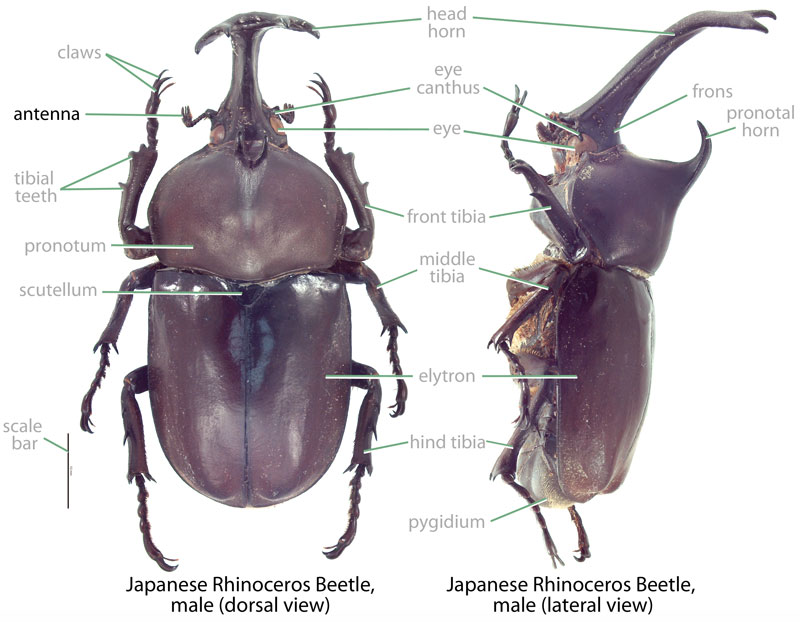What makes a scarab beetle? Scarabs, stags, and bess beetles are a cosmopolitan group of beetles that are characterized by an antennal clubantennal club:
the enlarged portion of the antennae, usually towards the apex (end) of the antennae
that is lamellatelamellate:
in reference to the antenna in which the club is formed from closely opposed, leaf-like or fan-shaped surfaces
 , a thorax that is modified for burrowing, and by the C-shaped, cream-colored immature stage (often referred to as larvaelarvae:
, a thorax that is modified for burrowing, and by the C-shaped, cream-colored immature stage (often referred to as larvaelarvae:
the immature form of an insect; in scarabs, also called grub or white grub; preceded by the egg stage, followed by the pupal stage
 or white grubs). Scarabs are cosmopolitan, are adapted to most habitats, and have a very wide range of feeding habits and preferences (fruits, roots, leaves, dung, fungi, and detritusdetritus:
or white grubs). Scarabs are cosmopolitan, are adapted to most habitats, and have a very wide range of feeding habits and preferences (fruits, roots, leaves, dung, fungi, and detritusdetritus:
organic debris; particularly plant debris
).
Is this a scarab beetle? The clubbed (or lamellatelamellate:
in reference to the antenna in which the club is formed from closely opposed, leaf-like or fan-shaped surfaces
 ) antennaeantennae:
) antennaeantennae:
paired sensory organ on head, formed from numerous segments
 are very characteristic for scarab beetles, but other beetle groups with similar antennaeantennae:
are very characteristic for scarab beetles, but other beetle groups with similar antennaeantennae:
paired sensory organ on head, formed from numerous segments
 may still fool you. Picnic beetles (or sap beetles; Nitidulidae) resemble scarabs and may be found in ripe fruit along with Asian flower beetles (Protaetia species). Some darkling beetles (such as Bolitotherus species; Tenebrionidae) have a similar appearance to scarabs that you might encounter in rotting wood or on the soil surface. Beneficial beetles found in dung include scarabaeoid dung beetles as well as water scavenger beetles (such as Sphaeridium species; Hydrophilidae) and clown beetles (or hister beetles such as Hister species; Histeridae). You can use the gallery to browse images to make certain that your specimen is a scarab beetle. Useful resources for scarab beetle identification (families, subfamilies, tribes, and genera) include the Generic Guide to New World Scarab Beetles and BugGuide.
may still fool you. Picnic beetles (or sap beetles; Nitidulidae) resemble scarabs and may be found in ripe fruit along with Asian flower beetles (Protaetia species). Some darkling beetles (such as Bolitotherus species; Tenebrionidae) have a similar appearance to scarabs that you might encounter in rotting wood or on the soil surface. Beneficial beetles found in dung include scarabaeoid dung beetles as well as water scavenger beetles (such as Sphaeridium species; Hydrophilidae) and clown beetles (or hister beetles such as Hister species; Histeridae). You can use the gallery to browse images to make certain that your specimen is a scarab beetle. Useful resources for scarab beetle identification (families, subfamilies, tribes, and genera) include the Generic Guide to New World Scarab Beetles and BugGuide.
What tools do I need to identify a scarab specimen? While images in this tool, in combination with a dissecting microscope or a hand lens, may be sufficient to diagnose adult Hawaiian and Guamanian scarab species, authoritative identification may require confirmation using male genitalia. Dissection of male genitalia is a common practice within entomology. Fact sheet diagnoses provide information on how to separate male and female individuals using morphological characteristics in sexually dimorphicdimorphic:
occuring in two distinct forms
species. Male genitalia may be extracted using a dissecting microscope and fine-pointed forceps. The male specimen is softened by placing it in hot water with a drop of liquid soap for 5-15 minutes. Softened specimens can be manipulated without fear of breakage, appendages can be re-positioned, and dirt can be removed. To dissect the male genitalia, hold the specimen to expose the ventralventral:
of or relating to the lower surface; opposite of dorsal
surface. The membrane between the abdomen and thorax is severed using the tip of the forceps, and the abdomen is removed. The hardened, sclerotized male genitalia can be found within the abdomen. Remove surrounding membranes and mount the male genitalia below the specimen on an insect point with glue. The dissection method may be viewed in the “Beetle Dissection and Imaging Tutorial.”
What about identifying scarab larvae? Rapid identification of invasiveinvasive:
a species that has recently arrived to a new location, usually via human activity, causing notable economic and/or ecological damage
species is essential for containment and eradication. Knowledge of scarab larvaelarvae:
the immature form of an insect; in scarabs, also called grub or white grub; preceded by the egg stage, followed by the pupal stage
 is limited, and less than 1% of scarab larvaelarvae:
is limited, and less than 1% of scarab larvaelarvae:
the immature form of an insect; in scarabs, also called grub or white grub; preceded by the egg stage, followed by the pupal stage
 are described. Identification of larvaelarvae:
are described. Identification of larvaelarvae:
the immature form of an insect; in scarabs, also called grub or white grub; preceded by the egg stage, followed by the pupal stage
 relies on patterns of setaesetae:
relies on patterns of setaesetae:
small, hair-like structure
, mouthparts, and claws, all of which require extensive dissection and microscopy. In order to advance detection and identification of new invasiveinvasive:
a species that has recently arrived to a new location, usually via human activity, causing notable economic and/or ecological damage
scarab species, this tool includes DNA barcode gene sequences for focal scarab larvaelarvae:
the immature form of an insect; in scarabs, also called grub or white grub; preceded by the egg stage, followed by the pupal stage
 . DNA barcoding allows non-experts to identify species objectively. Barcoding is used in forensic science, detection of food fraud, species discovery, and taxonomy (Goldstein and DeSalle, 2010Goldstein and DeSalle, 2010:
. DNA barcoding allows non-experts to identify species objectively. Barcoding is used in forensic science, detection of food fraud, species discovery, and taxonomy (Goldstein and DeSalle, 2010Goldstein and DeSalle, 2010:
Goldstein PZ and DeSalle R. 2010. Integrating DNA barcode data and taxonomic practice: determination, discovery, and description. Bioessays 33: 135–147. [DOI 10.1002/bies.201000036]). It employs a standardized gene region to aid in species identification by comparison with an online reference library of animal diversity (Ratnasingham and Hebert, 2007Ratnasingham and Hebert, 2007:
Ratnasingham S and Hebert PDN. 2007. BOLD: The Barcode of Life Data System (www.barcodinglife.org). Molecular Ecology Notes 7:355–364. [DOI: 10.1111/j.1471- 8286.2006.01678.x]).
How can I identify scarab groups? Useful resources for scarab beetle identification (families, subfamilies, tribes, and genera) include the Generic Guide to New World Scarab Beetles and BugGuide.
What if my specimen doesn’t fit any species accounts? This tool facilitates identification of known scarab species in Hawaii and Guam, as well as species with a high potential for introduction. If a specimen does not seem to fit any of the species accounts within this tool, then you should contact the USDA or a regional specialist and have it examined by an expert. Your specimen may represent a new range expansion of a new or known exotic species.